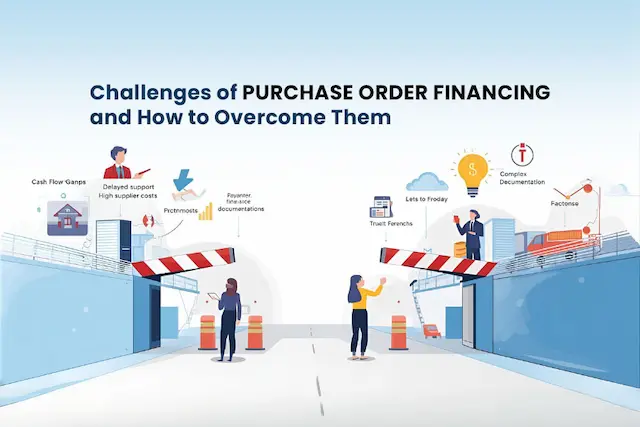As a business owner, you may need extra funding to grow your business or manage cash flow. Two popular options are purchase order funding and traditional loans. Each has its benefits, but their suitability depends on your business’s specific needs and circumstances. Purchase order funding helps you fulfill large orders by covering supplier costs upfront, while traditional loans provide a lump sum of money that can be used more flexibly.
Understanding the differences between these financing methods is crucial for making an informed decision about which option is right for your business. This article will compare and contrast purchase order funding and traditional loans, guiding you to choose the best fit for your financial needs.
What is Purchase Order Financing?
Purchase order (PO) financing is a type of funding designed to help businesses fulfill large orders, even when facing cash flow challenges. With PO financing, a lender pays your supplier the costs required to fulfill a customer’s order. Once the supplier delivers the products to the customer, you invoice the customer. The payment from the customer goes directly to the PO financing company, which deducts its fees before forwarding the remaining funds to you.
This financing option is particularly useful for seasonal businesses or rapidly growing companies needing extra capital to handle large customer orders. It is also beneficial for businesses experiencing cash flow shortages. Many PO financing companies evaluate the creditworthiness of your customers rather than your business, making it potentially easier to qualify for than other forms of business financing.
What are Traditional Business Loans?
Traditional small business loans are a conventional form of financing where you borrow a lump sum of money from a bank or financial institution and repay it over time with interest. The application process for these loans is often more complex and time-consuming than PO financing, with approval typically depending on your business’s credit history and financial health.
These loans can be used for various purposes, such as purchasing equipment, hiring staff, or expanding your business. However, they require regular repayments, which can strain your cash flow, particularly if your business is seasonal or has fluctuating income. Despite these challenges, traditional loans offer flexibility and can provide significant capital for diverse business needs.
Purchase Order Financing vs. Traditional Business Loans
When seeking additional funding for your business, it’s crucial to understand the differences between purchase order (PO) financing and traditional business loans. Both options have distinct advantages and potential drawbacks, and their suitability depends on your business’s specific needs and circumstances. Here’s a detailed comparison to help you make an informed decision.
Purchase Order (PO) Financing
How It Works:
-
- PO financing involves a lender paying your supplier for the cost of fulfilling a customer’s order.
- After the supplier delivers the products to your customer, you invoice the customer.
- The customer’s payment goes directly to the PO financing company, which deducts its fees before passing the remaining funds to you.
Advantages:
-
-
-
- Cash Flow Management: Ideal for businesses facing cash flow issues, as it covers supplier costs upfront.
- Easier Qualification: Often easier to qualify for since lenders focus on your customers’ creditworthiness rather than your business’s financial health.
- Supports Growth: Beneficial for rapidly growing businesses needing capital to fulfill large orders.
- Seasonal Flexibility: Helps seasonal businesses manage large orders during peak periods without straining cash flow.
-
-
Disadvantages:
-
-
-
- Cost: Typically involves higher fees compared to traditional loans.
- Dependency on Customer Payment: The financing is contingent on your customer paying their invoice on time, which could delay fund availability.
- Limited Use: Funds are restricted to specific orders and can’t be used for broader business needs.
-
-
Traditional Business Loans
How It Works:
-
-
-
-
-
- Involves borrowing a lump sum from a bank or financial institution, which you repay over time with interest.
- The application process includes a thorough review of your business’s credit history and financial health.
-
-
-
-
Advantages:
-
-
-
-
-
- Flexibility: Funds can be used for various purposes, such as purchasing equipment, hiring staff, or expanding your business.
- Predictable Repayment Schedule: Provides a structured repayment plan, making it easier to manage long-term financial planning.
- Lower Cost: Generally offers lower interest rates compared to PO financing, especially for businesses with strong credit histories.
-
-
-
-
Disadvantages:
-
-
-
-
-
- Complex Application Process: The application process can be time-consuming and requires detailed documentation and a solid credit history.
- Impact on Cash Flow: Regular repayments can strain cash flow, particularly for seasonal businesses or those with fluctuating income.
- Collateral Requirements: May require collateral, putting your business assets at risk if you default on the loan.
-
-
-
-
Which Is Right for Your Business?
With a detailed understanding of both Purchase order financing vs. traditional business loans, it’s equally important to understand which one is right for you:
Consider PO Financing If:
-
-
-
-
-
-
-
- You need to fulfill large orders but lack the cash flow to pay suppliers upfront.
- Your business is growing rapidly or is seasonal, requiring temporary boosts in capital.
- You have strong customers whose creditworthiness can support your financing application.
-
-
-
-
-
-
Consider Traditional Business Loans If:
-
-
-
-
-
-
-
- You need flexible funding that can be used for a wide range of business purposes.
- Your business has a strong credit history and can manage regular repayments without straining cash flow.
- You prefer the predictability of a structured repayment schedule and potentially lower financing costs.
-
-
-
-
-
-
Both purchase order financing and traditional business loans can provide essential support for your business. By understanding their differences, you can choose the option that best aligns with your financial needs and business goals.
Conclusion
Both purchase order financing and traditional business loans offer valuable solutions for different financial needs. Purchase order financing is ideal for managing large orders and cash flow issues, while traditional loans provide flexibility for diverse business purposes. Assess your business’s unique circumstances, growth stage, and cash flow requirements to determine the best financing option. By making an informed choice, you can secure the capital needed to drive your business forward.
Also Read : The Entrepreneur`s Guide to Purchase Order Financing for Startups




